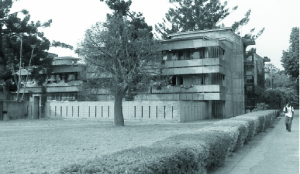
•Students who come from well-to-do families normally prefer to rent in expensive low density areas such as Marshlands, Kalundu and Thornpark, among other residential areas of Lusaka, because these locations have a secure environment.
By JOWIT SALUSEKI –
AMBITIONED with the desire to acquire quality education from reputable tertiary institutions in Zambia, most students who are not in boarding(residential) are finding alternative accommodation in expensive boarding houses in Lusaka’s Townships.
Because of the scarcity in accommodation, some houses in the capital city have been converted into boarding houses.
Against this backdrop, students who are not accommodated in their various campuses are faced with challenges of finding rented
apartments in residential places nearer to their learning institutions.
Much as the Government construction of the Levy Mwanawasa blocks at the University of Zambia (UNZA) aimed at increasing bed capacities at the institution, the shortage of accommodation continues to be a major challenge.
For instance, UNZA, with a student population of more than 10,000 per year, can only accommodate a fraction of the students owing to limited bed space.
This, therefore, entails that the remainder of the students either arrange to be squatting with their colleagues or opt to rent in the
infamous boarding houses.
The accommodation blues for students in Lusaka is not different from other tertiary institutions in other towns across the country.
Students, who come from well-to-do families normally prefer to rent in expensive low density areas such as Marshlands, Kalundu and Thornpark, among other residential areas of Lusaka, because these locations have a secure environment.
Other students, however, would rather rent in much cheaper boarding houses situated in sprawling townships such Lusaka’s Kalingalinga and Ng’ombe .
Some of the boarding houses are so crowded such that there is hardly any space for one to put books and other necessities because the space is only enough for a bunk bed.
The cheapest bunk bed in most of the low density Townships are pegged between K700 and K1, 500, while those in high density are at K500 per month.
Having lived in a boarding house, this author had endured the anguish that many student face in the apartments.
Whilst in the rented apartment, the writer faced a lot of challenges among them sharing a four plate cooker with 29 colleagues.
The dwelling place which we called home for more than two semesters was partitioned into three rooms with each room accommodating 10
students.
Ventilation was so poor such that one day when we realised as students that the landlord had taken our patience too far, we alerted a Lusaka City Council official on the matter of poor ventilation.
Within two days, the owner of the structure was visited by officials from the local authority and some improvements were made to the building, though not according to our satisfaction.
When it came to cooking evening meals, the writer and colleagues used to queue waiting for each other to finish preparing their meals.
During lunch time when each student was hungry and in a hurry to prepare Nshima in readiness to get back for afternoon lectures, there
were chaotic scenes as comrades would argue on who was first to put a pot on the cooker.
Out of frustrations, colleagues normally opted to buy fast foods, something they never usually budgeted for.
Among some of the many dos and don’ts for the boarding were that no student was allowed to cook foodstuffs such as dried beans so as to minimize on electricity consumption but some students defied that directive by cooking in the night when the owner of the house was asleep.
Disposal of waste material was problematic such that the polythene bags that were improvised as ‘trash cans’ used to get full before they
were emptied every after two weeks.
In some instances, the stench that used to come from the left over foods was not only very unbearable but attracted rodents, cats, and dogs that came to scavenge and in the process of doing so, the animals became a nuisance as they made a lot of noise.
In addition, the owner of the boarding house had put a curfew that saw every student to be indoors, regardless of whether one had gone for studies at the library However, not all students adhered to the curfew as they used to jump the parameter wall whenever they came late.
Visitations from the opposite sex were strictly prohibited unless very close family members but student always found answers to this puzzle.
What frustrated most students were a surcharge fee of 10 percent to student who delayed to pay rentals.
Some students who opted for refunds after finding alternative lodging elsewhere after paying their rentals had to part away with a 10
percent of the total payments.
Deciding to entrust the landlord with one’s belongings during vacations was not for free as a fee was charged.
No student was allowed to own any electric appliance apart from a portable computer and single pressing iron per room.
With all the hardships that we faced, we soldiered on until the end of our academic journey knowing what the future holds for us.
It is only hoped that the private sector will partner with the Government through the public private partnership initiative to build
more hostels in higher learning institutions so that students are not exploited by land lords through exorbitant rentals.






